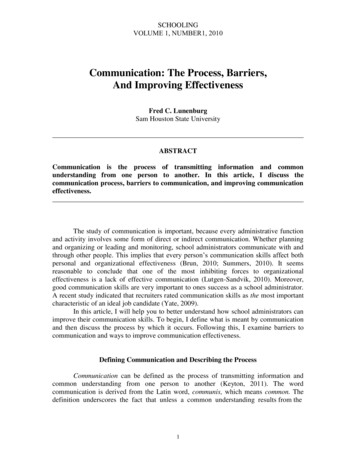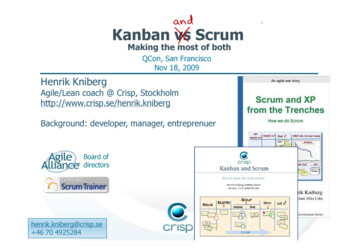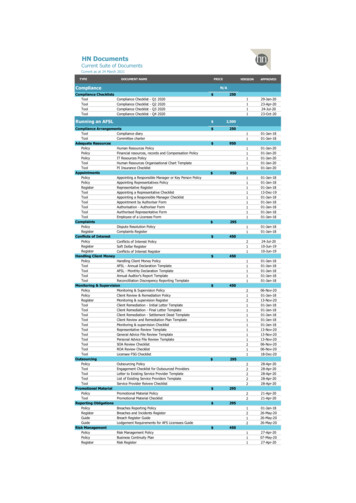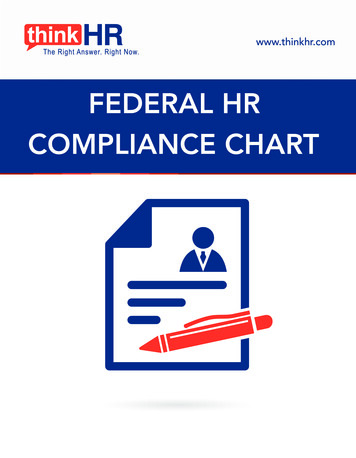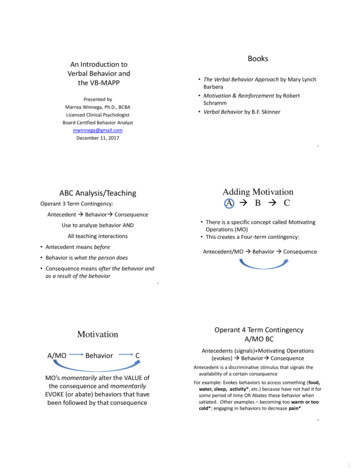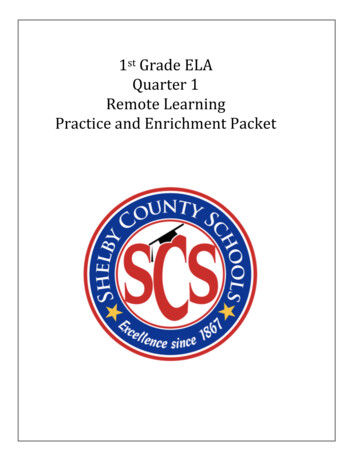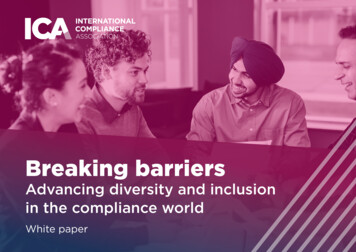
Transcription
Breaking barriersAdvancing diversity and inclusionin the compliance worldWhite paper1
ContentsForeword1Diversity and inclusion effortsand the compliance landscape2Whose responsibility is diversityand inclusion?11Hiring: An important focus area14How will a company know ithas achieved D&I?16
ICA WHITE PAPERForewordIn September 2020, we surveyed 300 members in the compliance field to determine how compliance is advancingdiversity and inclusion efforts and what challenges still exist to implementing an inclusive D&I programme.Compliance practitioners from various industries discussed the results from ‘Diversity and Inclusion in theCompliance World’ and offered a glimpse into D&I practices and policies within their own companies. They alsoexamined key takeaways from the survey. See inside for more insights and full survey results.38%of respondentssaid they hadexperienced somekind of discriminationin the workplaceMorethan a thirdof respondents saidcompliance regulations donot do enough to address D&I48%agreedthatregulations address D&Iin compliance, but saidmore could be doneExactlyhalfof those polled saidtheir company is fullycommitted to D&I137%said moreshouldbe done to advancediversity and inclusionat firms today13%of respondents said D&Ihasn’t been adequatelyaddressed at all
Diversity and inclusion efforts andthe compliance landscapeICA WHITE PAPERBy Erin Lynch, Compliance WeekIn fact, Elizabeth Adekoya, a Malta-based senior bankingadvisory consultant, says: ‘Discrimination is a longstandingissue in the world in general; therefore, of course, it alsoexists within the workplace’. Adekoya adds, ‘As with mostthings which have existed for a while and almost become the‘norm,’ changing this behaviour will take some time’.Nearly 40% of compliance practitioners surveyed recently byICA reported experiencing discrimination in the workplace atsome point in their careers, an unsurprising yet troublinglyhigh number, particularly in the wake of 2020’s globalreckoning on racial equality and inclusion.Compliance experts are not shocked by this finding from thepoll, titled ‘Diversity and Inclusion in the Compliance World’.For starters, it’s hard to quantify how inclusive a workplace is.Discriminatory behaviour can manifest in ways that are notobvious to an organisation, according to Jennifer Newton,founder and CEO of the National Association of BlackCompliance and Risk Management Professionals (NABCRMP)in the United States. ‘The overall impact of even unconsciousdiscrimination can still impose insidious consequences on theculture of the organisation as well as the career trajectory ofindividual victims,’ Newton says.Have you experienced any form of discriminationat your workplace?Yes - 38%(116 responses)Unconscious bias almost certainly comes into play here,especially in hiring practices, says Deborah O’Connor, aleadership and management tutor with a background incompliance. ‘Lack of diversity awareness is a key factorand involves more than mandatory regulatory-driven D&Itraining,’ she says.No - 62%(188 responses)2
ICA WHITE PAPERBiggest challenges in achieving D&IThere is a perceived moving line of what is and isn’t acceptablein various community groups today, Raz says. ‘Generationaldifferences and shifting norms have made defining a clearpath forward more complex and can lead to people holdingback their thoughts out of fear of offending someone.'If four out of every 10 employees experience discrimination,as the survey denotes, why don’t more people speak up?After all, most workplaces now have regular training on thesubject, a whistle-blower or hotline programme, and certainlymany companies at least claim a diverse and inclusiveworkplace is a high priority.A major consideration is many companies don’t connecthaving a diverse and inclusive workforce to meeting overallbusiness objectives. CalPERS CCO Marlene TimberlakeD’Adamo says it’s a goal of management to achieveoverarching D&I for the organisation.According to Cindy Raz, senior vice president of HR andorganisational development at NAVEX Global, job securityis certainly one factor. ‘Discriminatory behaviours andprogrammes have been painfully tolerated by many peoplegiven their fear of retaliation should they voice a concern When people fear the realities of a job loss or any type of acareer limitation, it’s understandable why they may pause onspeaking up,’ Raz says.‘It takes leadership to think that you or your organisationmight not have all the information. It takes leadership to aska question to which you may not get the answer you expector believe. What’s in it for senior management—the abilitypossibly to improve your culture, employee engagement, andthe performance of your organization.’A major consideration is that many companies don’t connecthaving a diverse and inclusive workforce to meeting overallbusiness objectives.3
What are the biggest challenges to starting a discussionabout diversity and inclusion in the compliance world?ICA WHITE PAPER10 sample survey responses:‘Too many people still think of diversity andinclusion as gender, race, or sexual orientation.It needs to be wider than that.’‘Generally, people who don't experience issueswith D&I don't think there are issues with it.’‘It is seen as an HR remit.’‘There are no obstacles to start discussions.Merely excuses.’‘The fear of saying the wrong thing, rather thanhaving a desire to learn and be educated.’‘People automatically assume you’re asking forsomething more than equality and compassion.They also don’t recognise they are speaking froma place of privilege.’‘Time, everyone is so busy.’‘Every jurisdiction could be facing a different typeof D&I issues; the problem with American andEuropean companies is that they assume theirD&I issues are the same in Asia.A one-size-fits-allapproach.’‘Different cultural values (West vs non-West).’‘Getting management to actually see value inD&I. Most see it as a PR stunt.’4
ICA WHITE PAPERFact: diversity is good for thebottom lineO’Connor agrees that the more diverse and inclusive andorganisation is, the more agile and creative it is. ‘It means thebusiness can adapt efficiently particularly in times of crises,because it consists of employees with different ways ofthinking and resolving challenges.’‘As risk and compliance officers, we are often the managersof risk—in all of its forms. The absence of diversity andinclusion in decision-making functions can create inevitableblind spots which, if unmitigated, can lead to negativeimpacts on the entire organisation,’ Newton says. ‘This iswhat makes diversity and inclusion a business issue ratherthan simply an HR issue.’Especially after the global COVID-19 pandemic, O’Connorbelieves ‘organisational psychologists will undoubtedlyexplore correlations between diverse workforces andorganisational agility, as these variables will have an impacton a company’s financial rebound,’ she says.But at the end of the day, notes NAVEX Global’s Raz, whenthe entire team feels seen, heard, safe, and cared for aspeople, their ‘desire to perform at their best level will onlyincrease.’ Ultimately, she says, ‘It is also not a hidden fact thatorganisations with a higher diverse workforce outperformthose with less diversity.An inclusive workplace increases employee morale, whichleads to higher productivity. This means employees will goabove and beyond in their roles ‘as they feel truly valuedas opposed to merely a cog in a wheel,’ Adekoya says.In addition, she cites increased employee retention anddecreased turnover as pluses.“The absence of diversity and inclusion indecision-making functions can create inevitableblind spots which, if unmitigated, can lead tonegative impacts on the entire organisation.– Jennifer Newton,Founder and CEO of NABCRMP5”
ICA WHITE PAPERThe benefits don’t stop there, either; becomingknown as an organisation that values D&I can have anincreasingly significant upside. ‘Consumers of todayseem to care more about diversity and inclusion thanever before and are willing to pay more for products andservices offered by companies that make a positive socialimpact,’ Newton says.Conversely, if your company is perceived as not caring,or isn’t factoring D&I into hiring, it can lead to costly,protracted employment discrimination lawsuits, not tomention customer and vendor complaints, and a negativeperception of your products or services.Safe to say, no one wants to be in that situation. All themore reason to give careful consideration to diversity in allforms: cultural, gender, but also cognitive and personalitytype. Ultimately, the goal needs to be ‘building organisationsrepresentative of the societies in which we live,’ O’Connor says.“Ultimately, the goal needsto be ‘building organisationsrepresentative of the societiesin which we live.”– Deborah O’Connor,Leadership and ManagementTutor and ICA Member6
ICA REPORTICA WHITEPAPERHow do you feel diversity and inclusion impacts compliance?10 sample survey responses:‘Diversity provides different ways of thinking, oflooking at things. These are often required toassess certain elements in a more holistic manner.’‘Missing out on talented individuals because of aperson's background, image, age, sex, heightand more.’‘Compliance people need to come from variedbackgrounds (and to be inquisitive aboutdifferent cultures and expectations).’‘The more diverse the Compliance Team thebetter the outcomes for the firms.’‘In some cases, D&I is treated as a ‘tick the box’compliance issue instead of appreciating thevalue a more diverse and inclusivework environment.’‘Lack of diversity may result in limited reach andone-sided points of view. Diversity within a groupis likely to create a good compliance base.’‘I don't believe it does, or if it does, I'm not aware.It's not a big issue where I'm located.’‘Diversity is crucial for every industry, butcompliance being such an ever-changingdiscipline, is imperative to learn fromdifferent perspectives.’‘When leadership is all male, the point of viewand actions are more in tune with traditionallymasculine qualities.’‘Equality, transparency, ethical behaviour has anoutcome on company culture and productivity.’7
ICA WHITE PAPERA diverse culture is often acompliant cultureAs many survey respondents noted, a diverse workforce leads to importantdiversity of thought and perspective, which is especially important incompliance. ‘[D&I] is important, because it introduces different opinionsand ideas to the discussion which can be beneficial in terms of developingcompliance strategies,’ wrote one compliance executive.‘A culture of diversity lends to culture of ethics and compliance,’ wroteanother survey taker, while a third said, ‘It helps the organization tosetup much better compliance ecosystem through a deeper and morecomprehensive worldview.’If compliance is largely based on the interpretation of data andrisk, it stands to reason you’d want the most diverse collection ofbackgrounds and perspectives to analyse that data.Managing that one colleague,who doesn’t seem to ‘get it’Chances are, you’ve heard the following statements from co-workersin discussing diversity and inclusion: ‘Why bother, I’ll just get it wrong.’‘I feel like everything I say offends someone.’‘Everyone’s so sensitive and politically correct these days.’‘Back in the good old days, you could say whatever you wanted.’Sadly, that’s an all too familiar sentiment at many companies; butthere are ways to guide employees on how to interact with theirrogue colleagues –those who aren’t on board with creating aninclusive environment.8
ICA REPORTICA WHITEPAPERFirst of all, read the room, says Adekoya. ‘Assess the situationto determine whether it is a safe environment to try to start adiscussion on D&I with the individual in a non-aggressive andnon-judgmental manner, to understand the reason why theydo not value D&I and try to educate them on the matter’.“Assess the situation todetermine whether it is a safeenvironment to try to start adiscussion on D&I (.).Of course, that’s not always advisable. If doing so would betoo contentious, consider raising the concern to a seniormanagement or, perhaps, human resources.Similarly, O’Connor says, ‘A review of the company’scommitment to D&I might be a good place to start. Use thecompany’s policies to raise your concerns with your linemanager or employee relations manager. Organisations mustwalk the talk.’– Elizabeth Adekoya,”Senior Banking Advisory ConsultantWhatever you do, don’t let bad behaviour go un-addressed,advises O’Connor. Yes, things like microaggressions mustbe handled sensitively, but ‘a team player’s ignorance todiscrimination or the offence caused sow seeds of division,affecting collaboration, morale, and ultimately team success,’she says. ‘It is important for the HR function and seniorleaders to act on concerns and look for possible signsthrough employee engagement surveys for example’.9
ICA WHITE PAPERDoes compliance have a diversity problem?10 sample survey responses:‘I don't think so. Not in my experience. Situationsoccurring are dealt with.’‘I think compliance has less of a diversity problemthan the wider industries we work in.’‘Yes. There are too many white men.’‘I think BAME candidates are still unrepresented.Regulations can be learned but candidatesfrom different sectors may bring a differentperspective and make a positive change.’‘Yes, coming from specific countries is still a reasonto discriminate people, while job searching.’‘Yes. Compliance is focused on white middle classwith a university degree.’‘Compliance tends to welcome femaleprofessionals. However, one still questions if theyare respected equally by their male counterparts.’‘I don't think that compliance has a diversityproblem - but entry to compliance possibly, it isexpensive to self-fund and this can be a barrier.’‘My team is very diverse across gender, ageand colour.’‘Lack of female representation at board level.’10
ICA WHITE PAPERWhose responsibility is diversityand inclusion?It’s long been a debate at many companies: where to put D&Iownership. Be it HR, the ethics function, another department,or the board, a company must first learn where D&I sitswithin the organisation before moving forward with a plan.inform stakeholders of such risks and to be educated enoughto inform them if their diversity and training programmes areineffective, especially if significant investment is placed intothem,’ Newton says. ‘The assessment and management ofdiversity risks should be fully aligned with other traditionalforms of risk management.’Notes Raz: HR and compliance will be most impactful whenworking together on D&I efforts. ‘They must equally share inthe commitment of building a culture that is rooted in doingthe right things consistently and prioritizing the experiencespeople deserve to have,’ she says. ‘By openly sharinginformation and insights with each other on how people cansafely thrive at their workplace, HR and compliance teamscan work together to ensure their board of directors isequipped with accurate workplace trends that may influencetheir organisation’s culture and success.’Do you think compliance regulations adequatelyaddress the issue of diversity and inclusion?36% (109 responses)Regulations fail toaddress D&I in compliance16% (49 responses)Yes, regulations adequatelyaddress D&I in complianceIn other words, HR and compliance should hold each otheraccountable in getting the right information in front ofthe board.O’Connor agrees. ‘The board, HR and compliance must beworking collaboratively to oversee, implement, and challengethe effectiveness of D&I programmes.’48% (144 responses)Yes, but more needs to be doneThe specific area of risk, however, is one compliance can own.As compliance and risk officers, we have the responsibility to11
ICA REPORTICA WHITEPAPERD&I: tangible first stepsTips on how to achieveworkplace D&INow that we know an inclusive workplace is good forbusiness, where and how does a company begin tocreate one? A company should first create a vision foran organisation that makes diversity and inclusion apriority, establishing diversity benchmarks, incentives, andaccountability frameworks, according to Jennifer Newton.By Elizabeth Adekoya,Senior Banking Advisory Consultant Establish regular D&I training for all employees.In addition, she says ‘Special training modules should alsobe created for management and employees that addressspecial risk areas such as implicit bias, microaggressionsand stereotyping.’ Initiate projects where individuals work with differenttypes of people and on engagements which theywouldn’t ordinarily. Make sure to specifically address D&I inrecruitment/hiring practices.And once the programmes are in place, the bosses are notdone. ‘It’s incumbent on senior management to alwayskeep a pulse on morale issues and workplace culture andenvironment,’ Newton says. Encourage open communication with ‘safe spaces’where employees can express workplace issues andareas for improvement without fear of repercussion. Regularly review D&I policies to make sure they arerelevant and impactful. Clearly establish the company’s tolerance fordiscrimination and the related consequences, and,perhaps more importantly, ensure that appropriateaction is taken whenever an issue arises.12
ICA WHITE PAPERIf this all sounds intimidating, you may be overthinking it,says Newton. ‘I do not think it is an overwhelming task tocreate inclusive workplaces for diversity of thought, cultureand personality differences The biggest challenge thatcompanies face in trying to implement these changes are aleadership structure or a tone at the top that does not seethe value in creating spaces that are intended to embracediversity in all of its forms,’ Newton says.Adekoya says in addition to establishing policies addressingD&I, companies must make them measurable. Without themeasuring, it’s impossible to know if what you’re doing isworking.And there’s no such thing as too early to start theconversation about the company’s values. ‘Diversity andinclusion is a very complex topic and regular dialogue isimportant from as early as onboarding and the induction ofnew employees,’ O’Connor says. ‘It is a chance to engage andconvey the organisation’s vision and strategy of an inclusiveworkplace, as well as learn about the uniqueness of anemployee and the value they will bring to the organisation’.Basically, as long as the top management is on board, thecompany is off to a good start.According to survey responses, some compliance executivesare taking informal steps on their own to create the rightenvironment. When asked what they were doing to makesure everyone feels included, respondents said, ‘making timefor 1:1’s and virtual coffees to check in,’ ‘creating an opendoor policy for raising issues,’ ‘taking a stand if somebody’sconcerns are belittled,’ and ‘ensuring everyone I work andinteract with knows they are valued’.“Diversity and inclusion is a verycomplex topic and regular dialogue isimportant from as early as onboardingand the induction of new employees.– Deborah O’Connor,Leadership and Management Tutor13”
Hiring: An important focus areaExperts agree that recruitment and hiring are two of themost important areas to focus D&I efforts. That starts withwhere an organisation looks for candidates, as there is atendency for hiring managers to rely on their own spheres ofinfluence and propagate a homogeneous environment.ICA REPORTICA WHITEPAPERBottom line: companies should focus on the specificcompetencies of the role in question, as opposed tohiring based on factors like race, gender, socioeconomicbackground, and academic institutions attended. At thesame time, they also must become more open minded intheir recruitment practices and consider candidates ofdifferent backgrounds.AJ Yawn, co-founder and CEO of compliance softwarecompany ByteChek, would advise an organisation to bewilling to go outside of the normal areas in searching forcandidates. ‘Visit Historically Black Colleges & Universities,and don’t just rely on referrals,’ Yawn says. After all, ‘There isnot a pipeline problem, there are plenty of qualified diversecandidates. It will just take additional effort and a change inapproach to find them.’“There is not a pipeline problem,there are plenty of qualified diversecandidates. It will just take additionaleffort and a change in approach tofind them.Also, consider whether your company’s job postings andrecruitment initiatives promote diversity. ‘Are decisionsto recruit evidence-based and transparent, relevant tothe business needs, and devoid of unconscious bias?’O’Connor asks. Who is responsible for the final decisions ona candidate, and what is the composition of the decisionmakers? ‘This is an area in which compliance can play arole in critically questioning the business Each businessfunction should be holding each other accountable in theirapproach to D&I.’”– AJ Yawn,Co-founder and CEO, ByteChek14
ICA WHITE PAPERWhere do companies tend to getD&I wrong?Similarly, Newton says it’s not enough to verbally recognisethe importance of diversity and inclusion. ‘Organisationsmust reflect this priority and commitment by resourcingthese initiatives and empowering employees tasked withimplementation of initiatives with decision-making authority.’For one, D&I programmes should never feel like anafterthought. According to the ICA survey, 50% of respondentssay their company is committed to diversity and inclusion,while the other half report either that their company hadmade strides but must do more, or hadn’t adequatelyaddressed the issue. Much work remains to be done.Another common mistake occurs when companies ‘resistor refuse to acknowledge the fact that certain issues existor downplaying the effects,’ Adekoya says. Or worse yet,companies get stuck in not knowing where to start and/orfear of offending people, and so they do nothing.Adekoya says, ‘It is vital to ensure that these initiatives are beingemployed and effectively, instilled within the corporate culture.’Furthermore, she warns, ‘Most organisations’ commitment toD&I stop at hiring individuals of diverse backgrounds, failingto recognise the support which is also needed to navigate theworkplace and deal with the discrimination and challengeswhich they will likely face because of their identity.An important ingredient in an inclusive workplace is theability to admit mistakes. ‘I would encourage leaders toopenly acknowledge when they’ve made an error andcheck in with people if they sense something they said wasexperienced differently than they intended,’ Raz says. ‘At theend of the day, we’re human and most people do try to dothe right thing, but we all trip on ourselves from time to time.We must give ourselves grace and consistently commit tolearning, listening and challenging our assumptions.’This sets the wrong tone, by marketing themselves as diverse& inclusion firms in appearance rather than practice.’Is your company committed to diversity and inclusion?Adekoya says intent matters, even if imperfect. ‘Speaking asa female person of colour who has experienced my fair shareof discrimination, I would advise that managers not hold backfrom engaging in this movement, as the intention to do betteris more valuable than anything’ she says. ‘I would be a lotmore understanding and forgiving of certain mistakes becauseof the intention behind them, as well as the individual’s effortsto educate themself, do better and bring about real change.’13% (39 responses)My company hasn’t adequatelyaddressed diversity and inclusion50% (151 responses)Yes, my company iscommitted to diversityand inclusionIn fact, the mistakes and fumbles are often the best learningopportunities for an organisation. ‘What matters most is theeffort that is put in to achieving an equitable workplace thatembraces the values of the organisation,’ Newton says.37% (112 responses)Yes, but more needsto be done15
ICA WHITE PAPERHow will a company know it hasachieved D&I?One thing to look for is whether a workforce is made up ofindividuals from a range of backgrounds across every level ofan organisation.While surveys are a helpful tool in measuring employees’perceptions on how inclusive and welcoming a workplace is,there is of course no quantifiable end point to D&I work.Another metric is how much – and how well – employees areinteracting. In a diverse and healthy environment, O’Connorsays, ‘employees will naturally collaborate, problem-solve,and innovate with little input from their managers. They willbe thinking about clients and communities they serve, and beproactive in their approach to attractingdiverse stakeholders.’‘I don’t think there will ever be a litmus test for determiningwhether an organisation has achieved a diverse and inclusiveworkplace,’ Newton says. ‘I think by its nature diversity andinclusion are matters of equity and perception.’Yawn advises a bit of creativity on the part of companies interms of D&I efforts. ‘This goes well beyond surveys or othertraditional methods of collecting feedback and requiresinnovative ways to hear from those that are directly impacted.’It’s fairly easy to tell whether a company is genuinelytrying, however, and that matters. ‘An organisation thatdemonstrates a commitment to truly embrace differencesand understands that diversity and inclusion is a constantwork in progress is in a much better place than anorganisation that is not willing to do that level of ongoingintrospection,’ Newton says.Ultimately, Yawn says, the answer can largely be gatheredby truly listening to your employees. ‘This doesn’t have to beguesswork,’ he says.16
About the InternationalCompliance AssociationThe International Compliance Association (ICA) is theleading professional body for the global regulatoryand financial crime compliance community. Since2001, we have enhanced the knowledge, skills andbehaviour of over 150,000 professionals around theglobe either through our internationally recognisedportfolio of professional qualifications (awarded inassociation with Alliance Manchester Business School,the University of Manchester) or through accreditedin-company training.www.int-comp.orgThis white paper was developed in conjunctionwith Compliance Week, a US-based informationservice on corporate governance, risk, andcompliance. Compliance Week is a sister companyto the International Compliance Association. Bothorganisations are under the umbrella of Wilmington plc.To read more visit: www.complianceweek.com.ICAB1411117
When people fear the realities of a job loss or any type of a career limitation, it’s understandable why they may pause on speaking up,’ Raz says. 3 There is a perceived moving line of what is and isn’t acceptable in various community groups today, Raz says. ‘Generational
